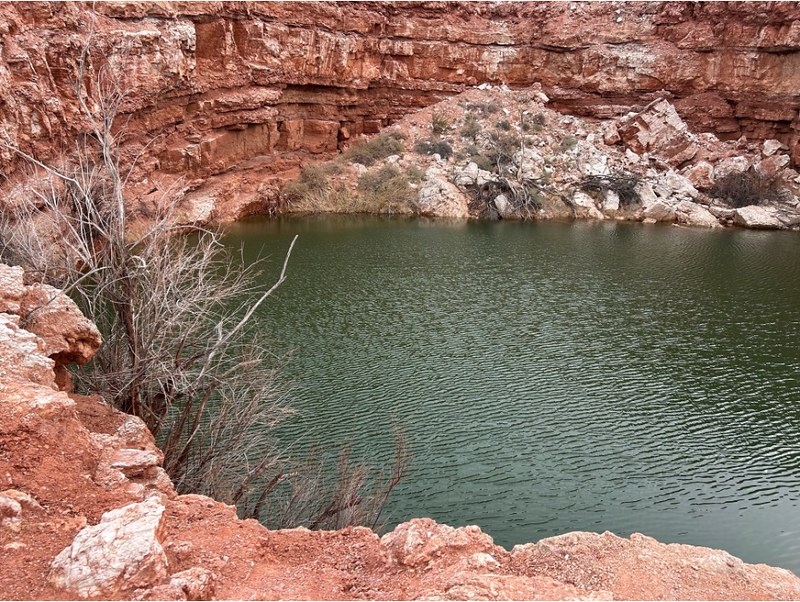Sinkholes
That the ground beneath our feet is solid is one of the anchors of our belief system. When something happens — say, an earthquake or a sinkhole opens up — the ensuing panic is because our basic belief system has been shaken. The Earth is not always solid.
Sinkholes form in areas underlain with limestone or dolomitic rocks. These carbonate rocks were deposited in shallow seas during the past half million years and underlay continents around the world, including here in the Ozarks. The carbonates are the exoskeletons of microscopic sea creatures and a few larger ones, just to keep things interesting. The cave systems found throughout the Ozarks are found in these carbonate layers that have been eroded by flowing water across the ages.
Rainwater is acidic in nature, with an average pH of between 5.0 and 5.6. Rainwater falling through the atmosphere intercepts carbon dioxide molecules and forms a weak carbonic acid solution. As carbon dioxide levels increase in our atmosphere, the pH of rainwater is becoming more acidic. The bleaching of coral reefs around the world is in part due to increased ocean temperatures but also because of the increased acidity of rainwater.
Geologists use the phrase “karst geology” to describe these underground erosional events. Rainwater seeps in through cracks in the earth and begins dissolving channels through the limestone and dolomite layers. Eventually a Swiss cheese-like rock forms, and water flows more freely. These perforated rocks are critical to humans. About a quarter of the freshwater supply used around the world is drawn from these honeycombed rocks.
Aquifers are the underground rivers that follow these perforated carbonate rock layers. The Edwards Plateau of central Texas is one of the largest and best-studied aquifer systems in the world. It is huge, encompassing 1,250 square miles and containing more than 50 million acre-feet of water. Though that’s a lot of water, the demands for water use are also high. Because the aquifer is relatively shallow and overlain with lots of fractured rock layers, the recharge rate is relatively high, yet withdrawals are currently exceeding the recharge rate by about 6 percent per year.
Another important characteristic of this honeycombed rock is that oil is found in them. Saudi Arabian oil fields — and most relatively shallow oil fields — gush out all that oil because the network of karst limestone is so extensive that oil just keeps flowing when a pumpjack removes it.
But let water flow through honeycombed rocks long enough and a hollowed-out cave forms. If the carbonate layer is close enough to the surface and there is not a strong sandstone ceiling, the roof can collapse. This can be sudden or gradual, but eventually, a pothole in the earth’s surface is left. The Yucatán Peninsula is pot-marked with these water-filled sinkholes. The one in the accompanying photo was taken in southeastern New Mexico. A string of eight or 10 500-foot-wide sinkholes have formed in a row as they follow the course of the underground river. In this case, gypsum deposits (calcium sulfate) are being dissolved. And the lakes aren’t bottomless. The deepest is only 90 feet deep, but the water that fills them comes from below-ground sources, not rainwater.
Sinkholes appear from time to time and make the news. My favorite sinkhole story occurred in 2014 when the floor of the National Corvette Museum in Bowling Green, Kentucky suddenly opened up and swallowed up eight vintage ‘vets. The hole was 60 feet long, 40 feet wide and 30 feet deep. But it turns out sinkholes are good promotion. That year, three million people visited, the largest number of attendees so far.
A friend and I were driving through the Arkansas woods heading to the Guion Ferry (before the bridge across the White River was built in the late 1980s) when he spotted a bare rock face in the woods. We stopped to investigate. It was a new sinkhole about 100 feet across that had dropped the soil perhaps 20 feet. To get there we had gone down one small ravine and up another hill and were several hundred feet from the road. There in the bottom of the sinkhole was an old couch. The effort to carry that old piece of furniture that distance just to dispose of it in a new hole in the ground spoke volumes of our base nature to pitch things in a hole.
| Gerald Klingaman is a retired Arkansas Extension Horticulturist and retired Operations Director for the Botanical Garden of the Ozarks. After more than two decades of penning the popular Plant of the Week column, he’s taking a new direction, offering views on nature as he pokes about the state and nation. Views and opinions reflect those of the author and are not those of the University of Arkansas System Division of Agriculture. If you have questions or comments for Dr. Klingaman about these articles contact him at [email protected]. |






